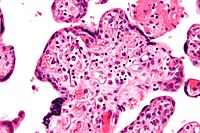
Photo from wikipedia
Trends in birthweight and abnormal fetal growth, namely term low birthweight (LBW), macrosomia, small-for-gestational age (SGA) and large-for-gestational age (LGA), are important indicators of changes in the health of populations.… Click to show full abstract
Trends in birthweight and abnormal fetal growth, namely term low birthweight (LBW), macrosomia, small-for-gestational age (SGA) and large-for-gestational age (LGA), are important indicators of changes in the health of populations. We performed this epidemiological study to evaluate these trends among 2,039,415 singleton live births from Israel over a period of 15 years. Birth certificate data was obtained from the Ministry of Health. Multivariable linear and logistic regression models were used to evaluate crude and adjusted estimates compared to the baseline of 2000 and polynomial trends. During the study period we observed a significant decrease in the rates of infants born SGA and LGA (10.7% to 9.2%, 10.2% to 9.6% respectively). After adjustment, based on the imputed data set, term mean birthweight increased by 6.0 grams (95% CI: 2.9, 9.1), and term LBW odds decreased by 19% in 2014 compared to 2000 (adj ORs: 0.81; 95% CI: 0.77, 0.85). Significant decreases were also observed for adjusted SGA, LGA and macrosomia rates. The decrease in abnormal fetal growth rates were not entirely explained by changes in sociodemographic characteristics or gestational age and may imply real improvement in child intrauterine growth in Israel during the last 15 years, especially in the Jewish population.
Journal Title: Scientific Reports
Year Published: 2018
Link to full text (if available)
Share on Social Media: Sign Up to like & get
recommendations!